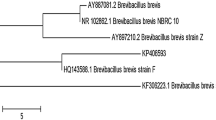Abstract
Foliar spray and micro-injection of plant growth-promoting rhizobacterial species,viz. Pseudomonas fluorescens andP. aeruginosa on chickpea induced synthesis of phenylalanine ammonia-lyase (PAL) when tested againstSclerotinia sclerotiorum. Induction of PAL was also associated with increased synthesis of phenolic compounds such as tannic, gallic, caffeic, chlorogenic and cinnamic acids. Treatment withP. fluorescens was found to be more effective in inducing phenolic compounds as compared toP. aeruginosa. However, persistence of PAL activity was observed more withP. aeruginosa. Although both the inoculation methods were effective, foliar application was found to be superior to micro-injection in terms of rapid PAL activity leading to the synthesis of phenolic compounds.
Similar content being viewed by others
Abbreviations
- HPLC:
-
high performance liquid chromatography
- IAA:
-
3-indolylacetic acid
- ISR:
-
induced systemic resistance
- KB:
-
King’s B (agar)
- Pf4 :
-
Pseudomonas fluorescens
- Pag :
-
Pseudomonas aeruginosa
- PAL:
-
phenylalanine ammonia-lyase (EC 4.3.1.5)
- PDA:
-
potato-dextrose agar
- PGPR:
-
plant growth-promoting rhizobacteria
- Sst :
-
Sclerotinia sclerotiorum
References
Bakker A.W., Schippers B.: Microbial cyanide production in the rhizosphere in relation to potato yield reduction andPseudomonas sp. mediated plant growth stimulation.Soil Biol.Biochem.19, 451–457 (1987).
Barry T.N., Manley T.R.: Interrelationships between concentrations of total condensed tannins, free condensed tannin and lignin inLotus sp. and their possible consequences in ruminant nutrition.J.Sci.Food Agric.37, 248–254 (1986).
Coley P.D.: Herbivory and defense characteristics of tree species in a low land tropical forest.Ecol.Monogr.53, 209–233 (1983).
Da Cunha A.: The estimation of phenylalanine ammonia lyase shows phenylpropanoid biosynthesis to be regulated byl-phenylalanine supply and availability.Phytochemistry26, 2723–2727 (1987).
Feenly P.: Plant apparency and chemical defense.Recent Adv.Phytochem10, 1–40 (1976).
Grey C.B., Cowan D.P., Langton S.D., Watkins R.W.: Systemic application ofl-phenylalanine increase plant resistance to vertebrate herbivory.J.Chem.Ecol.23, 1463–1470 (1997).
Hagerman A.E., Buttler L.G.: Chossing appropriate methods and standards for assaying tannin.J.Chem.Ecol.15, 1795–1810 (1989).
Hagerman A.E., Klucher K.M.: Tannin-protein interactions, pp. 67–76 in V. Cody, E. Middleton, J.B. Harborne (Eds):Plant Flavonoids in Biology and Medicine: Biochemical, Pharmacological and Structure Activity Relationships. Alan R. Liss, New York 1986
Hagerman A.E., Robbins C.T.: Implications of soluble tannin-protein complexes for tannin analysis and plant defense mechanisms.J.Chem.Ecol.13, 1243–1259 (1987).
Hahlbrock K., Scheel D.: Physiology and molecular biology of phenylpropanoid metabolism.Ann.Rev.Plant Physiol.Plant Mol.Biol.40, 347–369 (1989).
Havir E.A.:l-Phenylalanine ammonia lyase from soybeen cell suspension cultures.Meth.Enzymol.142, 248–253 (1987).
Hennin C., Diederichsen E., Hofte M.: Resistance to fungal pathogens triggered by the cf9-Avr9 response in tomato and oilseed rape in the absence of hypersenitive cell death.Mol.Plant Pathol.3, 31–41 (2002).
Jones D.H.: Phenylalanine ammonia lyase regulation of its induction and its role in plant development.Phytochemistry23, 1349–1359 (1984).
Mc Manus J.P., Davis K.G., Lilley T.H., Haslam E.: The association of proteins with polyphenols.J.Chem.Soc.Chem.Commun.7, 309–311 (1981).
Millar R.L., Higgins H.J.: Association of cyanide with infection birdsfoot trefoil byStemphyllium loti.Phytopathology60, 104–110 (1970).
Nicholson R.L., Hammerschmidt R.: Phenolic compounds and their role in disease resistance.Ann.Rev.Phytopathol.30, 369–389 (1992).
Pikovskaya R.E.: Mobilization of phosphorus in soil in connection with vital activity of some microbial species.Mikrobiologiya17, 362–370 (1948).
Purdy L.H.:Sclerotinia sclerotiorum: history, disease symptomatology, host range, geographic distribution and impact.Phytopathology69, 875–880 (1979).
Ramamoorthy V., Viswanathan R., Raghuchander T., Prakasam V., Samiyappan R.: Induction of systemic resistance by plant growth promoting rhizobacteria in crop plants against pests and diseases.Crop Prot.20, 1–11 (2001).
Sarma B.K., Singh U.P.: Ferulic acid may prevent infection ofCicer arietinum bySclerotium rolfsii.World J.Microbiol.Biotechnol.19, 123–127 (2003).
Sarma B.K., Singh U.P., Singh K.P.: Variability in Indian isolates ofSclerotium rolfsii.Mycologia94, 1051–1058 (2002).
Schwyn B., Neilands J.B.: Universal chemical assay for the detection and determination of siderophore.Anal.Riochem.160, 17–56 (1987).
Singh U.P., Sarma B.K., Singh D.P., Amar Bahadur: Plant growth promoting rhizobacteria-mediated induction of phenolies in pea (Pisum sativum) following infection withErysiphe pisi.Curr.Microbiol.44, 396–400 (2002).
Singh U.P., Sarma B.K., Singh D.P.: Effect of plant growth-promoting rhizobacteria and culture filtrate ofSclerotium rolfsii on phenolic and salicylic acid contents in chickpea (Cicer arietinum).Curr.Microbiol.46, 131–140 (2003).
Stoessi, A.: Secondary plant metabolites in preinfectional and postinfectional resistance, pp. 71–122 in J.A. Bailey, B.J. Daverall (Eds):The Dynamics of Host Defense. Academic Press, New York 1983.
van Loon L.C., Bakker P., Pieterse C.M.J.: Systemic resistance induced by rhizosphere bacteria.Ann.Rev.Phytopathol.36, 453–483 (1998).
Author information
Authors and Affiliations
Corresponding author
Rights and permissions
About this article
Cite this article
Basha, S.A., Sarma, B.K., Singh, D.P. et al. Differential methods of inoculation of plant growth-promoting rhizobacteria induce synthesis of phenylalanine ammonia-lyase and phenolic compounds differentially in chickpca. Folia Microbiol 51, 463–468 (2006). https://doi.org/10.1007/BF02931592
Received:
Revised:
Issue Date:
DOI: https://doi.org/10.1007/BF02931592




